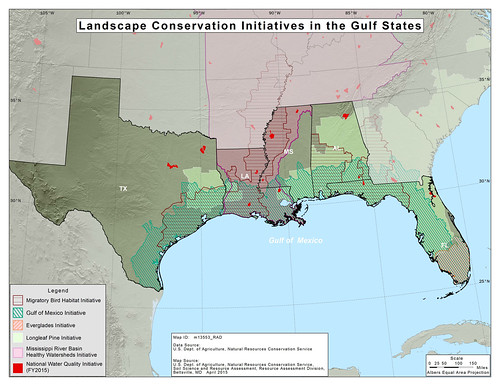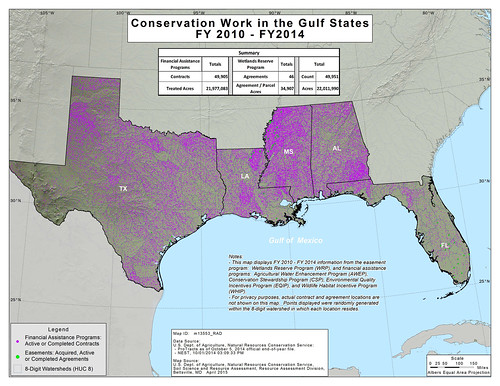Tens of thousands of farmers in the five Gulf states have put conservation practices on more than 22 million acres from fiscal years 2010-2014. Click to watch video.
In a time of need, America’s private landowners voluntarily made conservation improvements to their land to aid recovery following the Deepwater Horizon oil spill in the Gulf of Mexico region. Landowners are working with USDA’s Natural Resources Conservation Service (NRCS) to put conservation systems to work on their farms, ranches and forests that clean and conserve water, boost soil health and restore habitat – all while making their working lands more resilient.
Since 2010, tens of thousands have made conservation improvements to more than 22 million acres in the five Gulf states during fiscal years 2010-2014.
“Landowners are really interested and committed to doing good things on their lands, said Wesley Kerr, NRCS area conservationist in southern Mississippi.
Following the oil spill, NRCS accelerated its efforts to work side-by-side with landowners to get conservation on the ground. NRCS created landscape-level efforts, like the Migratory Bird Habitat Initiative (MBHI) and Gulf of Mexico Initiative (GoMI), as part of the agency’s way to give landowners the tools they need to be stewards of the land.
Just weeks after the spill, NRCS launched MBHI, an effort to aid landowners in creating alternative habitat for migratory birds. Landowners in an eight-state area created 470,000 acres of habitat for the millions of migratory birds, including ducks, geese and shorebirds, that travel the Mississippi Flyway each year to winter in Gulf of Mexico-area ecosystems, or in the case of many shorebirds, Central and South America.
NRCS launched GoMI in 2012 to accelerate conservation to Gulf-area watersheds most in need. This targeted work helped landowners trap and reduce runoff of nutrients and sediment, which can impair water quality, and restore habitat on about 60,000 acres during fiscal 2012-2014.
In addition to MBHI, GoMI and other landscape-level efforts, producers across the five states have implemented conservation practices that ultimately helps improve the Gulf of Mexico and other waterways.
NRCS has more than 450 service centers and 1,700 staff members in the five Gulf states, where NRCS conservationists work side-by-side with landowners to make conservation improvements to their farms, ranches and forests. This on-the-ground expertise makes NRCS and their work with landowners an important part in helping the Gulf rebound.
“What we try to do with our farmers in the county is offer them any kind of assistance we can whether it be information or financial assistance,” said Joey Koptis, NRCS district conservationist in Baldwin County, Alabama. “Anything that we can do up here on the upland, we know is going to affect the water quality as it gets eventually to the Gulf.”
To get started with NRCS, visit your local USDA Service Center or www.nrcs.usda.gov/GetStarted.

Landscape-level efforts, like the Migratory Bird Habitat Initiative and the Gulf of Mexico Initiative, have accelerated conservation in the region in an effort to improve water quality and enhance habitat.

No comments:
Post a Comment
Note: Only a member of this blog may post a comment.